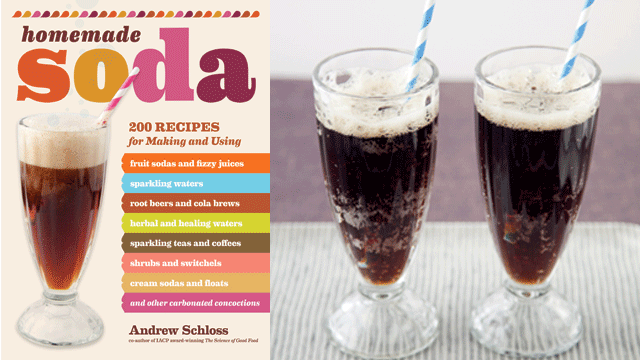
(Aran Goyoaga)
When was the last time you thumbed through a soda cookbook? Probably never.
Most soda cookbooks are about cooking with soda, and that’s never really fired anyone up. And making soda from scratch seems like a project for insanely eager DIYers. When something is so readily available, there doesn’t seem a point to making it yourself.
“But that is the whole point,” says Andrew Schloss, author of Homemade Soda. “It’s great to figure out how to take a commercial product and make it,” he says. And it’s easy.
Take Coca-Cola. Most things we eat taste similar to something else. But cola tastes only like, well, cola. “It’s extraordinarily unusual,” says Schloss. “It’s a one-of-a-kind complex brew combining ingredients you wouldn’t think would work together.”
Schloss’ recipe includes citrus oils, cinnamon, coriander, nutmeg, vanilla and bergamot--an aromatic oil derived from the rind of a Mediterranean citrus that’s used in perfume (it also gives Earl Grey Tea that particular aroma).
Soda is essentially a flavor base of extracts--fruit juice, tea, coffee--sweetened with sugar, that’s diluted and carbonated. Schloss’ recipes have step-by-step instructions for blending or brewing a base and provide carbonation and mixology instructions.
You can carbonate by adding bottled seltzer to the base or by using a CO2-charged soda siphon. Schloss also explains the science of going au naturel, carbonating by adding wine or champagne yeast. The yeast feeds off the base mixture’s sugar to produce carbonation.
There’s almost no taste difference between yeast-based and forced carbonation, says Schloss. There’s a textural difference. Forced-carbonation creates intensely fizzy bubbles. Yeast-based bubbles are softer and velvety.
Under attack today by conscientious high-fructose corn syrup objectors, sodas like Coke and Pepsi were originally medicinal. Most had caffeine (and still do), an effective headache-reliever, and citrus for refreshment.
“Acidity is what makes soda so refreshing,” explains Schloss, “and most of that comes from citrus.”
Pharmacists used to sell sodas as health tonics, sweetening their concoctions with sugar and adding carbonated water. Imagine Alka Seltzer with coloring and sugar. But it was more than just the recipe. People believed that sparkling water itself conferred health benefits.
Way back when, “taking the cure,” meant more than just drinking soda water. It meant soaking in it.
Ancient civilizations thought that a soak in naturally effervescent mineral springs was restorative and invigorating. People starting flocking to spas by the 1700s--“spa” coming from the Roman phrase “salude per aqua” or “health through waters.” By the late 1700s people began to drink those waters and by 1810 mass-produced carbonated water hit the market. By the 1850s most pharmacists started stepping behind their soda fountains to concoct a soda for whatever ailed you.
Some of Schloss’ recipes contain esoterica like gum arabic, a sap-derived thickener that adds body or Kitchen Bouquet, a turn-of-the-last-century caramel-based “browning” sauce that adds a rich, brown color. Others mix cool, on-trend ingredients like cocoa and ground ancho chiles, or caramel and salt. Others are just in-your-face eclectic—prune juice, chocolate syrup, and ground cinnamon.
Schloss includes chapters on colas, root beer, fruit, coffee and tea-based sodas, egg creams (sans egg and cream) and Shrubs and Switchels, 18th- and 19th-century vinegar-spiked sodas. Like salt, sourness sharpens our sense of taste; think “Sour Patch Kids” candies.
Schloss’ chapter on cooking could be entitled, “Beyond Coca-Cola Ham.”
Cooking with soda has the reputation of being dumbed-down cooking. It isn’t.
“You have to understand the ingredient, soda, for what it is rather than what its come to be—a pop culture staple,” says Schloss. Colas and root beers have “a lot of umami (i.e. complex and savory) flavors to play with,” he adds. His play resulted in recipes like Dr. Pepper corned beef, root beer baked beans, lemonade cocktail shrimp and cola chili.
As for baking and frying with soda, everyone knows that they lighten batters and cakes. Uh, no, says, Schloss. It’s beer’s alcohol that “lightens” a batter. When beer hits hot oil the alcohol evaporates more quickly than the water and gives a crispier crust. As for seltzer, “the bubbles disappear once you mix it in the batter,” he says. There is zero leavening effect.
Homemade Soda is all about taking something that people don’t think about making at home and teaching them how to make it at home. You can go basic with ginger ginger ale or all-out craft soda with coffee chocolate stout. If you get into it, just think: you’ll never lug home another case of soda again.
